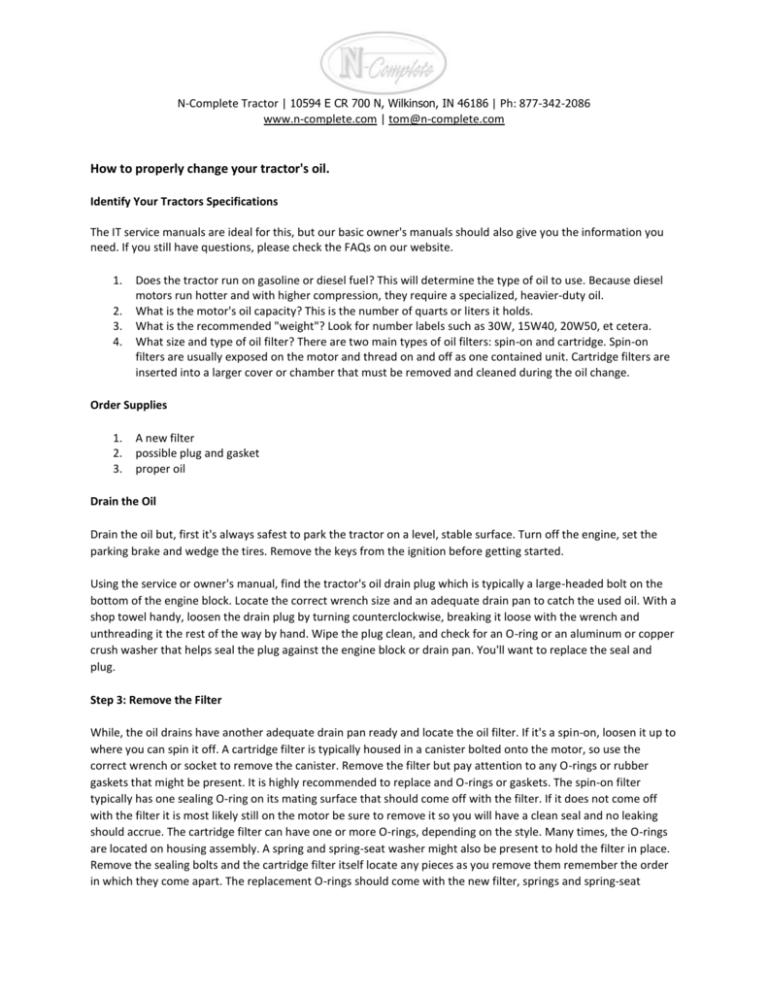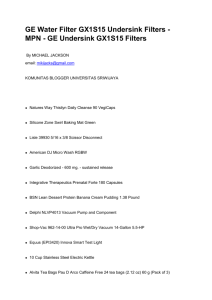N-Complete Tractor | 10594 E CR 700 N, Wilkinson, IN 46186 | Ph
advertisement

N-Complete Tractor | 10594 E CR 700 N, Wilkinson, IN 46186 | Ph: 877-342-2086 www.n-complete.com | tom@n-complete.com How to properly change your tractor's oil. Identify Your Tractors Specifications The IT service manuals are ideal for this, but our basic owner's manuals should also give you the information you need. If you still have questions, please check the FAQs on our website. 1. 2. 3. 4. Does the tractor run on gasoline or diesel fuel? This will determine the type of oil to use. Because diesel motors run hotter and with higher compression, they require a specialized, heavier-duty oil. What is the motor's oil capacity? This is the number of quarts or liters it holds. What is the recommended "weight"? Look for number labels such as 30W, 15W40, 20W50, et cetera. What size and type of oil filter? There are two main types of oil filters: spin-on and cartridge. Spin-on filters are usually exposed on the motor and thread on and off as one contained unit. Cartridge filters are inserted into a larger cover or chamber that must be removed and cleaned during the oil change. Order Supplies 1. 2. 3. A new filter possible plug and gasket proper oil Drain the Oil Drain the oil but, first it's always safest to park the tractor on a level, stable surface. Turn off the engine, set the parking brake and wedge the tires. Remove the keys from the ignition before getting started. Using the service or owner's manual, find the tractor's oil drain plug which is typically a large-headed bolt on the bottom of the engine block. Locate the correct wrench size and an adequate drain pan to catch the used oil. With a shop towel handy, loosen the drain plug by turning counterclockwise, breaking it loose with the wrench and unthreading it the rest of the way by hand. Wipe the plug clean, and check for an O-ring or an aluminum or copper crush washer that helps seal the plug against the engine block or drain pan. You'll want to replace the seal and plug. Step 3: Remove the Filter While, the oil drains have another adequate drain pan ready and locate the oil filter. If it's a spin-on, loosen it up to where you can spin it off. A cartridge filter is typically housed in a canister bolted onto the motor, so use the correct wrench or socket to remove the canister. Remove the filter but pay attention to any O-rings or rubber gaskets that might be present. It is highly recommended to replace and O-rings or gaskets. The spin-on filter typically has one sealing O-ring on its mating surface that should come off with the filter. If it does not come off with the filter it is most likely still on the motor be sure to remove it so you will have a clean seal and no leaking should accrue. The cartridge filter can have one or more O-rings, depending on the style. Many times, the O-rings are located on housing assembly. A spring and spring-seat washer might also be present to hold the filter in place. Remove the sealing bolts and the cartridge filter itself locate any pieces as you remove them remember the order in which they come apart. The replacement O-rings should come with the new filter, springs and spring-seat N-Complete Tractor | 10594 E CR 700 N, Wilkinson, IN 46186 | Ph: 877-342-2086 www.n-complete.com | tom@n-complete.com washers are usually reusable. Reinstall the Oil Filter Reinstall the oil filter coating all O-rings or rubber gaskets with fresh oil first. Some motors typically diesel motors with large vertically installed filters call for priming the oil filter before reinstalling: This simply means filling the filter assembly with new oil before it goes back on. Thread spin-on filters by hand until they sit against the motor, and then give another quarter to half turn until nice and snug. The filter needs to be tight but not wrenched on. Heat from motor use will expand the assembly and tighten the seal over time, and if it's wrenched on from the beginning, it will be a nearly impossible to change the filter again. Reassemble the cartridge filters unit as it came apart, then bolt the assembly back on, keeping the bolts tight but not too tight. Tighten the Drain Plug After the filter is installed, fix your new crush washer or O-ring on the drain plug and thread it in by hand until it seats. Again, tighten it down either by torque spec but remember to be sure not to cross thread the plug. Dispose of Old Oil Once, the filter and plug are installed and tight, wipe down and degrease your work surfaces. Remove your drain pans, emptying the used oil into a safe and adequate container to be disposed of. Refill with New Oil Locate your oil fill, which is usually near your tractor's oil level check dipstick and is sometimes the same. Using a funnel, fill the motor with the specified type, weight and amount of oil. Tighten the oil fill cap and or the dipstick. Check for Leaks With the transmission in neutral and the parking brake on, start and run the tractor at idle for at least 30 seconds, visually checking for leaks around the and drain plug. After confirming no leaks, shut down the motor and wait a few minutes, then check the oil level on the dipstick. If your specs are right, the level should be right on or at least close, though you might need to add or remove a small amount. When the level on the dipstick is correct, your oil change is done.









